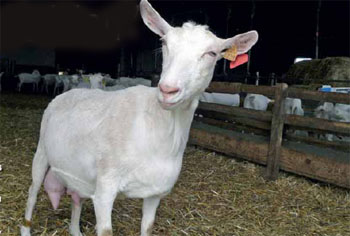‘Much is still unclear in goat nutrition’

Small ruminants form a special group within the ruminant section. In January, the French association of animal nutritionists Aftaa, organised a special conference on goat nutrition. With an attendance of 71 delegates the seminar was a great success, showing the need for extensive nutritional information among goat farmers.
By Philippe Caldier
| Many dairy goat farmers follow several nutritional programs. Good strandards for goat nutrition are scarce. |
Several feed valuing systems for dairy goats exist all over the world: American NRC goat tables (2007), French INRA data (2007) and a Spanish reference from Cannas & Pulina (2008). Intake prediction models for dairy goats are based on a general regression model where feed intake is linked to live weight and milk yield standardised to 3.5% fat. “These references for goats are not good for us,” said Gerardo Caja, from the Department of Animal & Food Sciences of the University of Barcelona. Caja explains to the delegates that goats of 60 kg live weight producing 4 kg milk/d simply don’t exist in Spain. “You need to test existing models, as values of feed intake prediction vary according to the model used”, argued Caja who then presented the results of a meta analysis based on 125 papers and 85 selected experiments. From these studies it was shown that the average goat has an average bodyweight of 51.3 kg (varying from 29 kg to 85.5 kg), a daily dry matter intake of 2.2 kg (0.8 to 3.5 kg/d) and produces 2.7 kg of milk per day (0.4-6.2 kg). Caja concluded from this analysis that standard valuing systems overestimate intake at low milk yield and underestimate intake at high milk yield, suggesting further research is required.
Heat stress
Caja also elaborated on heat stress in goats. He said that goats perform well in arid-hot zones. Goats are more tolerant to heat stress than dairy cows for various reasons: lower body weight, morphological adaptations (long ears, etc.), greater water conservation capacity and sweating rate, and behavioural adaptations. “Few studies have been carried out on heat stress and mid-term effects in dairy goats,” he said. He presented the conclusions of an experiment conducted in the climatic chamber of the experimental station of the university in Bellatera. The main conclusions of the trial (made with eight goats of the Murciano-Granadina breed) were as follows:• Dairy goats are partially adapted to heat stress conditions after week 3;
Caja also elaborated on heat stress in goats. He said that goats perform well in arid-hot zones. Goats are more tolerant to heat stress than dairy cows for various reasons: lower body weight, morphological adaptations (long ears, etc.), greater water conservation capacity and sweating rate, and behavioural adaptations. “Few studies have been carried out on heat stress and mid-term effects in dairy goats,” he said. He presented the conclusions of an experiment conducted in the climatic chamber of the experimental station of the university in Bellatera. The main conclusions of the trial (made with eight goats of the Murciano-Granadina breed) were as follows:• Dairy goats are partially adapted to heat stress conditions after week 3;
• Lower dry matter intake for heat stressed goats, but similar milk yield compared to thermo neutral group when fed with the same feed;
• Mobilised body reserves in week 1 to maintain milk yield;
• Decreased milk protein, but similar milk fat;
• No effect on digestibility;
• Similar N retention, but ingested N might have been directed to other functions rather than milk protein synthesis.
“Further studies are needed to test heat stress effects in early lactation”, concluded Caja who also wants to clarify whether reduced milk protein content is related to a nutrient limiting factor or reduced mammary protein synthesis.
Multiple answers to concentrate
In a second presentation, Daniel Sauvant from AgroParisTech focused on the relation between dairy production levels and concentrate consumption. An additional supply of 100 g of concentrate was followed by a drop of 35 g of dry matter of ingested forage/kg milk and improves goat milk production by 52 g. According to Sauvant, the energy value of the forage is a key factor in covering the requirement of the goats for milk production, in particular the quality and the digestibility of the supplied forages. The intake of forage is not only linked to its bulk and to the concentrate supply, since the goat’s answer is only one third (+ 100 g of forage = +33 g ingested only). “Sorting is a major feeding behaviour of the goat”, said Sauvant who indicates there is a lack of standardised methods today to assess fibre size (some fibres have the property to stimulate chewing). “There is a big individual variation from one goat to another in feeding behaviour,” added a delegate during the presentation. Some goats have a slow ingestion and a good
In a second presentation, Daniel Sauvant from AgroParisTech focused on the relation between dairy production levels and concentrate consumption. An additional supply of 100 g of concentrate was followed by a drop of 35 g of dry matter of ingested forage/kg milk and improves goat milk production by 52 g. According to Sauvant, the energy value of the forage is a key factor in covering the requirement of the goats for milk production, in particular the quality and the digestibility of the supplied forages. The intake of forage is not only linked to its bulk and to the concentrate supply, since the goat’s answer is only one third (+ 100 g of forage = +33 g ingested only). “Sorting is a major feeding behaviour of the goat”, said Sauvant who indicates there is a lack of standardised methods today to assess fibre size (some fibres have the property to stimulate chewing). “There is a big individual variation from one goat to another in feeding behaviour,” added a delegate during the presentation. Some goats have a slow ingestion and a good
rumen regulation pH, while other goats have a quicker ingestion which may lead to acidosis. The goat’s appetite may also vary from one day to the other. “We should do more to prevent acidosis in goat units as they are an increasing problem creating losses for the farmers”, said Sauvant.
More automation
Stéphane Saille, technical head of ruminants for Prisma (part of InVivo), recalls that in France the share of farms having more than 200 goats increased from 9 to 22% in the period 2000-2009. In the last four years, goat productivity increased from 760 to 818 kg milk/year, with a stabilisation of the protein content and a slight increase of fat percentage. “Feed costs represent 70% of the total costs of a goat farm,” he adds. From 1990 to 2005, the feeding systems have changed in two ways: transition from wet rations to dry ones, and more automation in the feed supply (feed cars, robots, individual concentrate distributors). “Automation allows increasing the number of meals per day and increases the productivity of the herd (better growth margin/employee). But today investment choices face a lack of short term and long term visibility for the farmers. Milk prices also dropped for French goat farmers recently and more and more rumours are circulating regarding a possible production quota in the sector.
Stéphane Saille, technical head of ruminants for Prisma (part of InVivo), recalls that in France the share of farms having more than 200 goats increased from 9 to 22% in the period 2000-2009. In the last four years, goat productivity increased from 760 to 818 kg milk/year, with a stabilisation of the protein content and a slight increase of fat percentage. “Feed costs represent 70% of the total costs of a goat farm,” he adds. From 1990 to 2005, the feeding systems have changed in two ways: transition from wet rations to dry ones, and more automation in the feed supply (feed cars, robots, individual concentrate distributors). “Automation allows increasing the number of meals per day and increases the productivity of the herd (better growth margin/employee). But today investment choices face a lack of short term and long term visibility for the farmers. Milk prices also dropped for French goat farmers recently and more and more rumours are circulating regarding a possible production quota in the sector.
Mineral requirements
François Meschy (ex Inra research engineer) and Yves Lefrileux (in charge of the trials at the experimental station of Le Pradel in the department of Ardèche) presented a paper on goat mineral requirements. Meschy said that there were few specific data available for dairy goat mineral requirements, explaining that most of these data are extrapolations from bovine and ovine requirements. “Almost none of the usual rations are able to comply with the overall goat mineral requirements”, Meschy said. Table 1 presents the current knowledge on goat mineral requirements. Meschy concludes that 1) the type of mineral feed depends on the basic ration, 2) for a mineral feed assessment first the level of ingestion needs to be evaluated, and 3) it is of high interest to make regional references available regarding trace elements values.
François Meschy (ex Inra research engineer) and Yves Lefrileux (in charge of the trials at the experimental station of Le Pradel in the department of Ardèche) presented a paper on goat mineral requirements. Meschy said that there were few specific data available for dairy goat mineral requirements, explaining that most of these data are extrapolations from bovine and ovine requirements. “Almost none of the usual rations are able to comply with the overall goat mineral requirements”, Meschy said. Table 1 presents the current knowledge on goat mineral requirements. Meschy concludes that 1) the type of mineral feed depends on the basic ration, 2) for a mineral feed assessment first the level of ingestion needs to be evaluated, and 3) it is of high interest to make regional references available regarding trace elements values.
According to Lefrileux, goat farmers have numerous concerns about mineral supplementation: interest, practical aspects (presentation, consumption heterogeneity), supply problems, and how to balance. A practical survey among 104 goat farms in the Drôme and Ardèche departments showed the various habits the farmers use to complement feed for their flocks: dried alfalfa (38%), cereals (87%), cakes (16%) or ready feed from the market (77%), but many different mixes exist. Nearly half of the farmers only distribute one mineral feed, 19% two, 14% three and 18% four different feeds. Distribution procedures also vary: ad libitum (17%), ad libitum + concentrate supply (15%), with concentrates (60%), drinking water (2%), drinking water + concentrate (2%). Lefrileux therefore concluded that “To evaluate the intake, farmers do an approximate balance, with huge differences between requirements and supplies and a bad estimation of the left-over rate (not consumed feed).”











